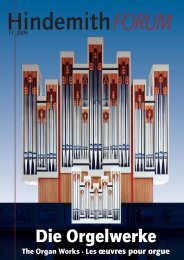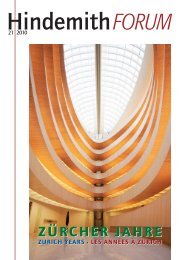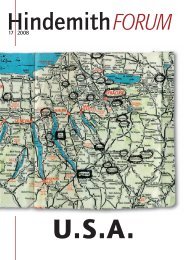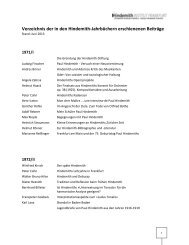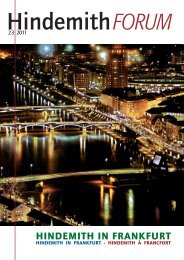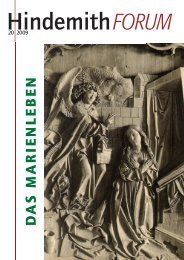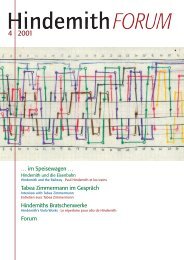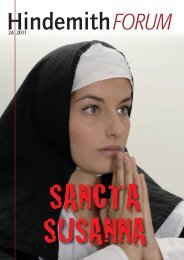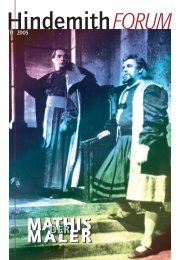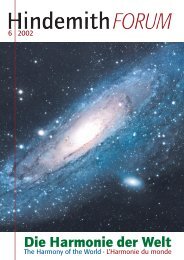cardillac - Paul Hindemith
cardillac - Paul Hindemith
cardillac - Paul Hindemith
You also want an ePaper? Increase the reach of your titles
YUMPU automatically turns print PDFs into web optimized ePapers that Google loves.
Ouvertüre zum „Fliegenden<br />
Holländer“ wie sie eine<br />
schlechte Kurkapelle morgens<br />
um 7 am Brunnen vom Blatt<br />
spielt für Streichquartett (um<br />
1925); Minimax – „Repertorium<br />
für Militärmusik“ für Streichquartett;<br />
4. Streichquartett<br />
op. 22 (1922)<br />
Kocian Quartet<br />
◆ Praga Digitals CD 350036<br />
(2007)<br />
Während die beiden Parodiewerke<br />
Auskoppelungen aus der Gesamteinspielung<br />
aller Quartettwerke<br />
<strong>Hindemith</strong>s des Ensembles aus<br />
Prag von 1995 repräsentieren – das<br />
war damals die sehr verdienstvolle<br />
erste Gesamteinspielung dieser<br />
Werke überhaupt – handelt es sich<br />
bei der Aufnahme des 4. Streichquartetts<br />
op. 22 um einen Live-<br />
Mitschnitt einer Aufführung vom 25.<br />
März 2005 in Dijon. Und tatsächlich<br />
merkt man dieser Aufnahme an,<br />
wie sehr doch das Kocian-Quartett<br />
seit den Aufnahmen von 1995 an<br />
Spielkultur und Souveränität gewonnen<br />
hat. Das ist eine willkommene<br />
Ergänzung der <strong>Hindemith</strong>-<br />
Aufnahmen des Ensembles.<br />
While the two parody works represent<br />
couplings from the 1995 complete<br />
recording of all of <strong>Hindemith</strong>’s<br />
works for quartet by the<br />
ensemble from Prague – that was<br />
the very first complete recording of<br />
these, to be commended – the<br />
recording of the 4 th String Quartet,<br />
Op. 22 is a live recording of a<br />
performance of 25 March 2005 in<br />
Dijon. And one does indeed notice<br />
the extent to which the Kocian<br />
Quartet has grown in performance<br />
culture and sovereignty since the<br />
1995 recording. This is a welcome<br />
addition to this ensemble’s <strong>Hindemith</strong><br />
recordings.<br />
Alors que les deux pièces parodiques<br />
sont extraites d’une intégrale<br />
des œuvres pour quatuor de<br />
<strong>Hindemith</strong>, réalisée par le quatuor<br />
de Prague en 1995 – à l’époque, il<br />
s’agissait même du premier enregistrement<br />
intégral, fort méritoire,<br />
de ces œuvres –, le présent enregistrement<br />
du Quatrième quatuor<br />
op. 22 a été capté, en direct, lors<br />
d’un concert donné le 25 mars<br />
2005, à Dijon. C’est l’occasion de<br />
<strong>Hindemith</strong>-Forum 16/2007<br />
remarquer dans cet enregistrement<br />
les progrès sensibles que le Quatuor<br />
Kocian a réalisé depuis les<br />
enregistrements de 1995 tant au<br />
niveau de sa culture de l’œuvre<br />
que de sa maîtrise de l’exécution<br />
musicale. Un CD bienvenu qui vient<br />
compléter les contributions de cet<br />
ensemble à l’enregistrement du<br />
répertoire de <strong>Hindemith</strong>.<br />
Theme with four Variations<br />
(according to the four Temperaments)<br />
for String Orchestra and<br />
Piano (1940)<br />
Manuel de Falla, Ludwig van<br />
Beethoven, Robert Schumann,<br />
Frédéric Chopin<br />
Sinfonie-Orchester des Hessischen<br />
Rundfunks, Winfried Zillig<br />
Walter Gieseking, Piano<br />
◆ Music & Arts 2 CD 1074(2)<br />
(2001)<br />
Walter Gieseking, einer der ganz<br />
großen, stilbildenden Pianisten des<br />
vergangenen Jahrhunderts, zählte in<br />
den 1920er Jahren zu den bedeutendsten<br />
<strong>Hindemith</strong>-Interpreten. So<br />
hat er etwa die Kammermusik Nr. 2<br />
als einer der Ersten in den Vereinigten<br />
Staaten bekannt gemacht und<br />
auch Konzerte mit dem Amar-Quartett<br />
gegeben, dem <strong>Hindemith</strong> als<br />
Bratscher angehörte. Die Aufnahme<br />
der Vier Temperamente von 1952<br />
scheint leider die einzige Aufnahme<br />
eines <strong>Hindemith</strong>-Werkes mit ihm<br />
als Pianisten zu sein, die sich erhalten<br />
hat. Das ist sehr bedauerlich;<br />
denn mit seinem ungemein klaren,<br />
hellen, transparenten und dabei<br />
agilen Spiel lockert er die kontrapunktische<br />
Anlage des <strong>Hindemith</strong>schen<br />
Klaviersatzes wie selbstverständlich<br />
atmosphärisch-virtuos auf<br />
und läßt ihn weit ausschwingend<br />
wirklich „klingen“.<br />
Walter Gieseking, one of the very<br />
great pianists of the past century,<br />
one of the creators of a pianistic<br />
style, was considered one of the<br />
most important <strong>Hindemith</strong> interpreters<br />
during the 1920s. He was<br />
one of the first to familiarise listeners<br />
in the USA with the Kammermusik<br />
Nr. 2, and also gave concerts<br />
with the Amar Quartet, in which<br />
<strong>Hindemith</strong> was the violist. Unfortunately,<br />
the recording of the Four<br />
Temperaments of 1952 seems to<br />
be the only recording of a <strong>Hindemith</strong><br />
work with him as pianist<br />
that has survived. This is most<br />
regrettable, for he livens up the<br />
contrapuntal construction of <strong>Hindemith</strong>’s<br />
piano writing with his<br />
incredibly clear, bright, transparent<br />
and agile playing, completely naturally<br />
and with virtuoso atmosphere,<br />
allowing its wide vibrations to<br />
really “sound.”<br />
Walter Gieseking, l’un des plus<br />
grands pianistes à avoir marqué le<br />
style du siècle précédent, comptait,<br />
dans les années 1920, parmi les interprètes<br />
les plus célèbres de <strong>Hindemith</strong>.<br />
Ainsi, aux Etats-Unis, il est<br />
l’un des premiers musiciens à avoir<br />
présenté, par exemple, la Kammermusik<br />
n° 2 et à avoir donné des<br />
concerts avec le Quatuor Amar,<br />
dans lequel <strong>Hindemith</strong> jouait la<br />
partie d’alto. L’enregistrement des<br />
Vier Temperamente de 1952<br />
semble être malheureusement le<br />
seul qui ait été conservé d’une<br />
œuvre de <strong>Hindemith</strong> jouée au<br />
piano par Walter Gieseking. C’est<br />
très regrettable, car la lecture qu’il<br />
en donne est extrêmement claire,<br />
lumineuse et transparente. Elle ne<br />
manque pas non plus d’être très<br />
agile, assouplissant presque<br />
naturellement la structure du<br />
contrepoint du mouvement pour<br />
piano en créant une atmosphère<br />
virtuose : Walter Gieseking laisse<br />
longuement « sonner » son instrument<br />
en déployant un jeu nuancé.<br />
Player Piano 4 – Original<br />
Compositions of the 1920s<br />
Toccata (1926)<br />
Igor Strawinsky, Hans Haass,<br />
Ernst Toch, Gerhart Münch,<br />
Nicolai Lopatnikoff, Alfredo<br />
Casella, Gian F. Malipiero,<br />
Marcel Duchamp, George Antheil<br />
Bösendorfer Grand Piano<br />
◆ Dabringhaus und Grimm CD<br />
645 1404-2 (2007)<br />
Hier liegt endlich eine Aufnahme<br />
der <strong>Hindemith</strong>schen Toccata für<br />
mechanisches Klavier vor, die in<br />
der Tempogestaltung und der Dynamik<br />
authentisch wirkt. <strong>Hindemith</strong><br />
komponiert die Toccata ganz aus<br />
den Möglichkeiten des durch eine<br />
Rolle angetriebenen mechanischen<br />
Klaviers heraus und bietet einen<br />
ungewohnten Klavierklang mit<br />
Tonkaskaden, die keine Pianisten<br />
spielen könnten. <strong>Hindemith</strong> soll<br />
denn auch das Werk, zu dem weder<br />
Skizzen noch überhaupt ein<br />
Notentext überliefert sind, gleich in<br />
die Rolle gestanzt haben. Es bleibt<br />
bedauerlich, daß <strong>Hindemith</strong> nur<br />
wenige Werke für mechanische Instrumente<br />
komponiert hat.<br />
Here is finally a recording of <strong>Hindemith</strong>’s<br />
Toccata for player piano<br />
which has an authentic effect in its<br />
tempo and dynamics. <strong>Hindemith</strong><br />
composed the Toccata completely<br />
out the possibilities of the player<br />
piano driven by a roll, offering an<br />
unusual piano sound with cascades<br />
of notes that no pianist could ever<br />
play. <strong>Hindemith</strong> is said to have<br />
punched the work directly into the<br />
roll; neither score nor any sketches<br />
of the work have survived. It remains<br />
regrettable that <strong>Hindemith</strong><br />
composed only a few works for<br />
mechanical instruments.<br />
Cet enregistrement présente, enfin,<br />
une interprétation de la Toccata<br />
pour piano mécanique très authentique<br />
quant à la conception du<br />
tempo et de la dynamique. <strong>Hindemith</strong><br />
compose la Toccata entièrement<br />
à partir des possibilités du<br />
piano mécanique, entraîné par un<br />
rouleau, qui permet des sonorités<br />
inhabituelles et des cascades de<br />
notes qu’aucun pianiste ne parviendrait<br />
à jouer seul. On a laissé<br />
entendre que <strong>Hindemith</strong> aurait<br />
directement composé l’œuvre sur<br />
le rouleau ; il n’en existe d’ailleurs<br />
aucune esquisse ni partition. Au vu<br />
du résultat, on peut regretter qu’il<br />
n’ait composé que peu d’œuvres<br />
pour instrument mécanique.<br />
GS<br />
17



